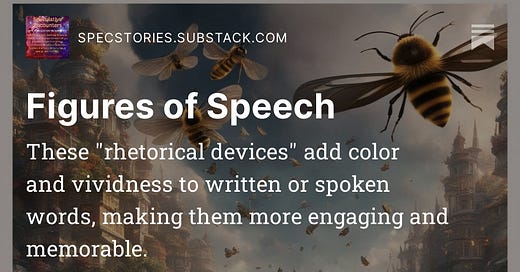Figures of Speech
These "rhetorical devices" add color and vividness to written or spoken words, making them more engaging and memorable.
Figures of speech, often called rhetorical devices, are powerful tools that writers use to enhance the richness and depth of their language. They add color and vividness to written or spoken words, making them more engaging and memorable. Let's explore some common figures of speech and how creative fiction writers can best utilize them in their stories.
1. Simile: A simile is a comparison that uses "like" or "as" to connect two seemingly unrelated things. For example, "Her smile was as bright as the sun." Similes create vivid imagery by drawing parallels between familiar and unfamiliar concepts.
2. Metaphor: Metaphors, like similes, draw comparisons, but they do so by directly stating that one thing is another. For instance, "The world is a stage." Metaphors can provide deeper insights into characters or situations by linking them to something else.
3. Personification: This figure of speech attributes human qualities to non-human entities or objects. For example, "The wind whispered through the trees." Personification can make inanimate objects come to life, adding emotional depth to the narrative.
4. Hyperbole: Hyperbole involves exaggeration for emphasis or effect. It's often used to create humor or intensify emotions. For instance, "I've told you a million times." In fiction, hyperbole can emphasize a character's personality or add comedic elements.
5. Onomatopoeia: Onomatopoeia words imitate the sounds they represent, like "buzz" or "sizzle." They engage readers' senses and can create a vivid auditory experience in your writing.
6. Alliteration: Alliteration is the repetition of consonant sounds at the beginning of words in close proximity. For example, "Sally sells seashells by the seashore." It can add rhythm and musicality to your prose, making it more appealing to readers.
7. Symbolism: Symbolism involves using objects, characters, or actions to represent abstract ideas or concepts. For example, a red rose might symbolize love. Symbolism can add layers of meaning to your story and allow readers to interpret it on multiple levels.
8. Irony: Irony involves a contrast between expectation and reality. There are several types of irony, including situational, verbal, and dramatic. Irony can create suspense, surprise, or humor in fiction.
9. Oxymoron: An oxymoron is a combination of contradictory words, like "bittersweet" or "jumbo shrimp." It can add complexity and depth to character descriptions or thematic elements in your story.
10. Allegory: Allegory is a narrative in which characters and events symbolize deeper moral, political, or philosophical concepts. For example, George Orwell's "Animal Farm" is an allegory for the Russian Revolution. Using allegory can enable writers to explore complex themes and issues.
Creative usage of figures of speech is the art of transforming ordinary words and phrases into literary gold, enriching stories and captivating readers through the skillful use of figures of speech. Aspiring fiction writers should embrace them to craft tales that resonate with your readers long after they've turned the final page.
<The following articles explore and explain each of the figures of speech above in detail.>
Keep reading with a 7-day free trial
Subscribe to StoryAngles to keep reading this post and get 7 days of free access to the full post archives.





